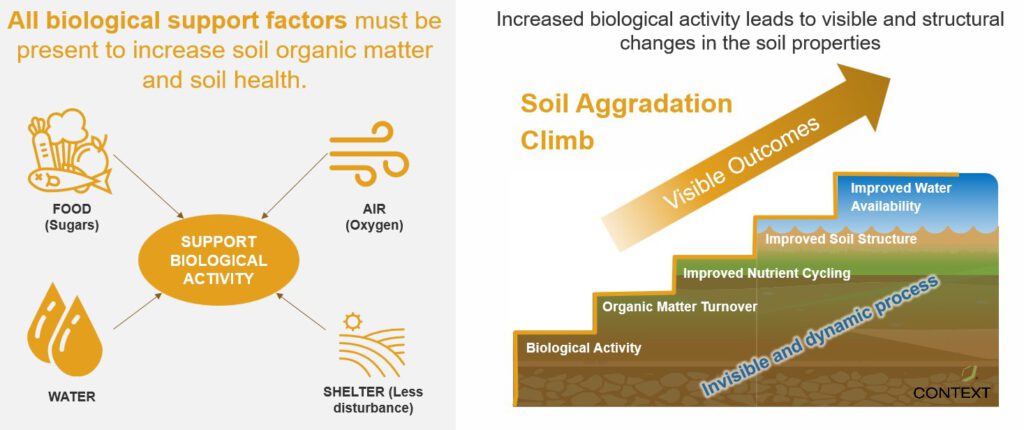How Does Farm Management Impact Soil Health?
Content has been adapted from The Context Network “Get Smart, Stay Smart” Ag Carbon Service.
The short answer: Changing management practices to foster biological activity is the key to improving soil health.
Back it up: Healthy soils are teeming with life. A single teaspoon of soil can contain as many as 1 billion bacteria. Invisible to the naked eye, bacteria are hard at work changing the soil structure and creating conditions for improved organic matter turnover, nutrient cycling, soil structure, and water availability.

Figure provided by the Context Network, LLC.
But how can changing land management improve soil health?
Adopting practices that support biological activity is the first step to seeing the visible outcomes of improved soil health.
Imagine that you’re farming microbes. Microbes need food, air, water, and shelter. Here are four ways you could improve their environment:
- Provide food in the form of organic matter. Keep crops growing as often as possible—their roots secrete sugars that bacteria consume. Keep residues on the field—the organic matter provides another food source.
- Provide shelter by minimizing soil disturbance. Decreasing tillage—or moving to conservation tillage—is the best way to provide shelter for microbes. Implementing cover crops or strip cropping to prevent topsoil erosion is another good way to minimize disturbance.
- Provide air by improving soil structure. Air is present in soil pores—roots need oxygen, just as microbes do. Over time, as bacteria and other microbes feed on sugars and plant tissue, the soil structure improves, increasing air flow to both plant roots and microbes in the soil.
- Provide water by maintaining it in the soil (in dry areas) or making sure there is adequate drainage (in wet areas). Leaving crop residue on fields and building up soil organic matter are both good ways to help improve water availability over time.
The big picture: Over time, farming invisible microbes creates visible changes in soil structure and aggradation.
- Biological activity results in better organic matter turnover, which leads to improved nutrient cycling.
- A healthy soil, teeming with microbes, means there are plenty of microbes present to break fertilizers down into structures that plants can use. It means improved nutrient use efficiency by plants—more of the fertilizer applied goes toward plant growth and yield.
- Given time, biological activity provides better soil structure, with plenty of pore space, aggregate stability, and improved organic matter.
- These factors lead to improved water availability for plants.
Changing management practices to consider the invisible aspects of soil health—microbes—is a great way to improve your soil health.
Photo by Lance Cheung and courtesy of USDA.








